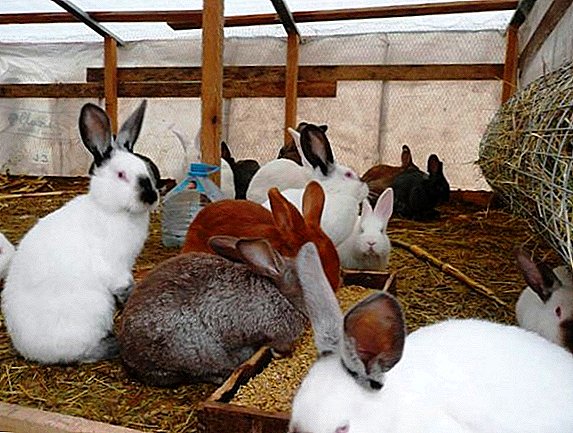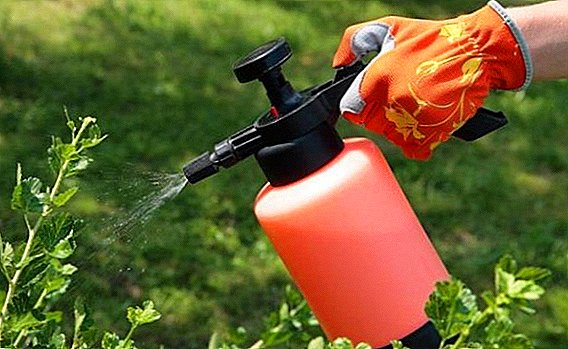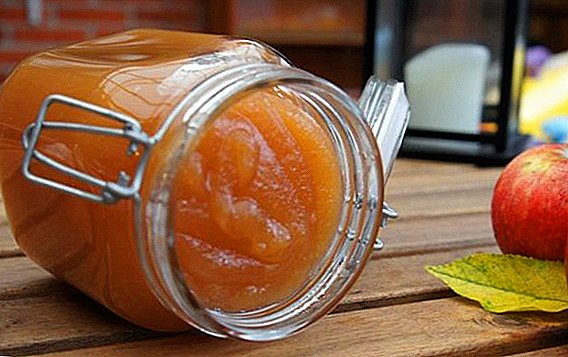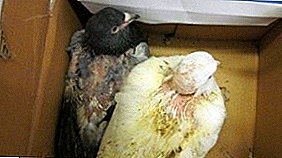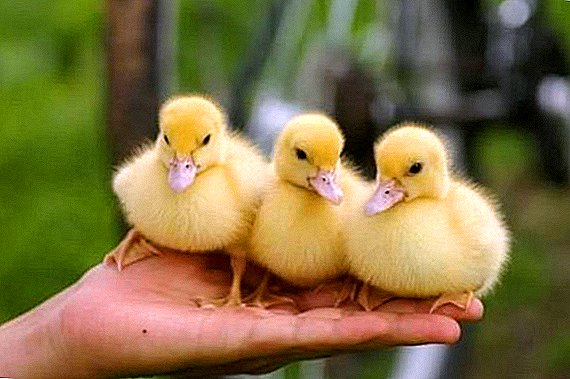 No matter how well we cared for our pets, but it is very difficult to eliminate all possible causes of the onset of diseases, therefore, in order to respond in time and take the necessary measures, it is necessary to navigate a little in the symptoms and consequences of certain ailments.
No matter how well we cared for our pets, but it is very difficult to eliminate all possible causes of the onset of diseases, therefore, in order to respond in time and take the necessary measures, it is necessary to navigate a little in the symptoms and consequences of certain ailments.
Duck Diseases
Diseases of ducklings are divided into infectious and those that are non-infectious in nature. First, we list non-infectious diseases. 
Non-infectious
When an unbalanced diet and a lack of any necessary substances in the diet of ducklings can cause diseases that are not associated with infections.
Learn how to feed ducklings in the first three weeks.
Non-communicable diseases are avitaminosis, cuticle, omphalitis, and urax disease.
Avitaminosis
The lack of vitamins and minerals in the diet of ducklings causes avitaminosis. Sick birds are not a threat to other individuals.
The following factors may indicate problems:
- chicks slowly gain weight and grow poorly;
- low survival rate of young stock;
- lack of appetite.
Did you know? Kirghiz have a belief that the prophet's daughter-in-law, having bathed in a forbidden lake, turned into a red duck. Due to the origin of the duck from a person, Muslims did not eat duck meat.
This problem can be solved by determining which vitamin is not enough and adding it to the feed. 
With a deficiency of vitamin A, the following symptoms occur:
- loss of appetite;
- depressed state;
- dry eyes, sometimes the presence of sores;
- discharge of fluid from the nostrils.
The disease develops slowly. For her treatment, it is necessary to give ducklings a green mass, pine meal, carrots, as well as fish oil and vitamin A.
Avitaminosis D is accompanied by such manifestations:
- curvature of the limbs and problems with movement;
- stunting;
- development of rickets.
Symptoms will disappear with the addition of fish oil, vitamins D2 and D3. For the production of vitamin D, ultraviolet rays are needed, so the chicks should be in the sun, and in its absence, artificial irradiation with ultraviolet light must be created. 
The following factors will indicate a lack of vitamin E:
- lethargic condition;
- reluctance to eat;
- cramps and weak pulse;
- eyes covered for a long time.
To cure you need to enter into the diet greens, carrots, potatoes, yeast, bran and dairy products, as well as tocopherol (1 drop at each feeding).
With a deficiency of vitamin B1 in the body of the young disturbed metabolism.
Symptoms are:
- growth retardation;
- head thrown back;
- in advanced cases, paralysis develops.
The treatment uses yeast, fresh greens and germinated grain, as well as vitamin B1. 
Violation of oxidation and protein synthesis is caused by a lack of vitamin B2.
This is evidenced by the following signs:
- cessation of growth;
- loss of appetite;
- anemia and anemia;
- curvature of the paws.
Dairy products, yeast, meat and bone and fish meal, wheat germ should be added to the feed.
With vitamin B12 deficiency, protein absorption is impaired.
Signs are:
- lack of appetite;
- weakness;
- cramping of the limbs;
- inability to move;
- anemia.

For treatment, animal products and dairy products are introduced into the diet. When beriberi are used drugs such as "Tetravit", "Aminovital" or "Trivitamin."
Level disease
The lack of substances of mineral origin can trigger the onset of urovsky disease.
Its symptoms are:
- pulling out feathers;
- ingestion of sawdust, earth or sand.
An introduction to the diet of crushed chalk, bone meal and iodized salt will help in the cure. 
Cuticle
In the first month, the young are sometimes affected by cuticle (alimentary gastritis), in which ulcers and necrotic lesions appear on the stomach cuticle.
It will be useful for you to learn how to cut duck wings, how to make a barn for ducks with your own hands, how to make feed for ducks, as well as how to properly and quickly pluck a duck at home, than useful duck fat and duck eggs.
The disease is caused by a lack of vitamin A and it is indicated:
- dark-colored diarrhea with undigested food residue;
- lethargy of chicks;
- lack of appetite.
When treating cuticle, vitamin A, nicotinic acid and iron sulfate are added to the feed. It is advisable to water the water-floating solution of potassium permanganate, but it should be of low concentration in order to avoid burns of the esophageal mucosa. 
Omphalite
Sometimes the tissues around the umbilical ring become inflamed.
This disease is called omphalitis and manifests itself:
- redness, swelling and swelling of the tissues around the navel;
- sometimes pus is secreted;
- chicks huddle together, stand with their heads bowed.
Did you know? According to Greek mythology, a flock of ducks did not allow Penelope (Odyssey's wife) to drown. The name Penelope translates as "teal" - river ducks.
In the fight against the disease are used ointments with antibiotic action. Before this, the skin is cleaned with disinfectant solutions (hydrogen peroxide or furatsilin). Then the inflamed area is treated with ointment. 
Infectious
Fledglings are often affected by various infections. Considering that many infections are not treated, it is necessary to identify them in time and isolate the diseased or destroy them so as not to lose all the livestock. We will talk about the symptoms and treatment of the most common infectious diseases.
Coccidiosis
Ducklings aged from 2 to 6 weeks are most vulnerable to coccidia. Microorganisms, getting into the body of young animals, are parasitic on the intestinal mucosa. This is fraught with the death of the epithelial layer, and the toxins secreted by the Eimeria cause inflammatory processes in the mucous membrane.
Violated intestinal work.
On the defeat of coccidiosis indicate:
- dark brown diarrhea with blood;
- food and water intake stops;
- rapid weight loss;
- ducklings are weak and slow;
- dehydration leads to death;
- 5-7 days after infection, paralysis occurs.
Most often the diseased bird is destroyed, but the treatment started on time may be positive. Nestlings are isolated and treated with "Norsulfazol" (added to water) and "Osarsol". 
You can also use the drug "Furazolidone", which is poured into the feed. It is very important in accordance with the instructions to accurately calculate the dose of drugs.
Tuberculosis
The disease develops slowly and may occur after 10 months. In chicks most often affects the lungs, and other organs - much less frequently than in other birds. The disease is transmitted through droppings, feed or by airborne droplets.
Important! Sick bird is destroyed. The disease is transmitted to humans, so meat and eggs should not be used as food.
Symptoms of tuberculosis can be:
- mucosal lesions;
- swollen joints;
- eczema on the skin.

Runny nose
Ducklings up to two months often suffer from a cold. This is especially characteristic of the cold season. The disease is contagious, and in a short period a large number of young stock can get sick. The behavior of birds practically does not change, but a characteristic symptom is a strong discharge from the nostrils and eyes.
The treatment uses a weak solution of manganese, which is dripped into the nose and eyes. 
Viral hepatitis
This infection affects the liver of chicks. Most often waterfowl get sick in the first two weeks, then immunity is produced.
The characteristic signs of the disease are:
- convulsions and convulsions;
- dropping the head and laying down on its side;
- conjunctivitis;
- labored breathing;
- bluish color mucous.

Sinusitis
The disease affects the respiratory tract in waterfowl under the age of 1.5 months.
Sinusitis is characterized by:
- shortness of breath with wheezing;
- the chicks sneeze and strongly open the beak;
- swelling of the eyelids and lacrimation;
- convulsions.
For treatment use the drug "Terramycin", which is added to food according to the instructions. 
Salmonellosis
Dangerous disease, which in half of the cases ends with the death of waterfowl. The causative agent is Salmonella bacteria. Infection occurs most often through food and water, but it can also occur through the mucous membrane of the eye or the respiratory tract. The incubation period lasts from days to seven. Ducklings suffer the disease in acute form.
It has the following symptoms:
- feeling of thirst;
- weakness and malaise;
- swelling of the mucous membranes;
- frothy diarrhea with blood;
- eyes watery and sour;
- frequent sneezing;
- lowered wings.
The disease is difficult to treat. Sick birds are isolated and given "Tetracycline" (40 mg per 1 kg of weight). But more often the birds are slaughtered, as the rested birds remain carriers. 
Hymenolepiasis
The disease is caused by parasites settling in the intestines of chicks.
These symptoms indicate hymenolepiasis:
- growth retardation;
- weakness and depression;
- indigestion;
- intestinal problems;
- often there is a disorder of coordination and convulsions.
In the fight against helminths help "Fenasal" and "Bitionol". The medicine is mixed into the feed at the rate of 0.3 g of Fenasal or 0.6 g of Bitionol per 1 kg of live weight. 
Preventive measures
It is easier to prevent the occurrence of the disease than to fight it, therefore, in order for the ducklings to be healthy, it is necessary to take some measures:
- maintain cleanliness in the room, disinfect drinking bowls and feeders. The equipment can be treated with bleach (400-500 g per 10 liters of water) or spray the room with 40% formalin solution. Good results are obtained with a blowtorch;
- it is not advisable to keep birds of different species and ages in one bird house;
- the floor can be sprinkled with lime, and the top is well covered with a litter (about 5 cm) of chopped straw or wood chips. The litter should be regularly loosened and replaced with a dry one;
- For the prevention of diseases with various infections, the first 5 days the ducklings are fed with Baytril or Enroxil (1 ml per 1 l of water);
- for prevention, it is advisable to vaccinate;
- The diet of chicks should be varied and rich in vitamins and minerals. Instead of water, chicks can drink a pale pink solution of potassium permanganate;
- young animals should be regularly inspected for timely detection of diseases. Finding any warning signs, it is better to contact the veterinarian.
Observing all preventive measures, maintaining cleanliness and diversifying the nutrition of the livestock, you can hope that your birds will grow healthy. 
Why do ducklings fall to their feet
Weakness and falling on legs can be signs of more than one disease. Some of them we mentioned in our article.
But in a generalized version, the main reasons can be:
- unbalanced diet, which lacks any necessary substances;
- the presence of parasites.
Important! In any case, it is better to consult a specialist so that he can make the correct diagnosis and prescribe treatment (if necessary) or help in adjusting the diet.
In case of lack of vitamins or microelements, they should be added to the diet in the form of food or special preparations. When parasites are detected, appropriate antiparasitic drugs are prescribed, we mentioned this when talking about some diseases. 
In order for your pets to be healthy, you need to pay enough attention to them and create comfortable conditions for them. The caring owners of the birds are full and healthy. But if you still have any problems, it is better to contact the experts.



